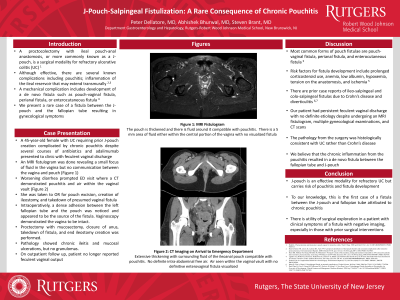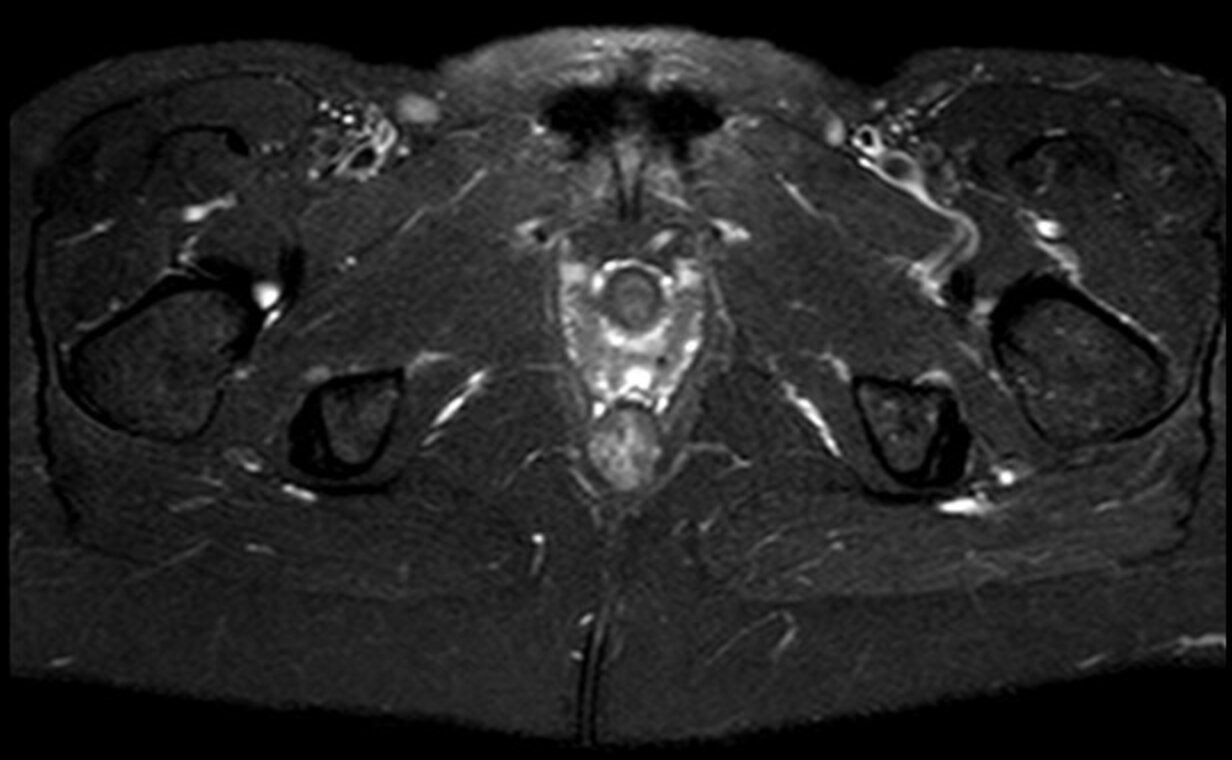Back


Poster Session A - Sunday Afternoon
Category: IBD
A0415 - J-Pouch-Salpingeal Fistulization: A Rare Consequence of Chronic Pouchitis
Sunday, October 23, 2022
5:00 PM – 7:00 PM ET
Location: Crown Ballroom

Has Audio
- PD
Peter Dellatore, MD
Rutgers Robert Wood Johnson Medical School
New Brunswick, NJ
Presenting Author(s)
Peter Dellatore, MD1, Abhishek Bhurwal, MD2, Steven Brant, MD3
1Rutgers Robert Wood Johnson Medical School, New Brunswick, NJ; 2Rutgers Robert Wood Johnson University Hospital- New Brunswick, New Brunswick, NJ; 3Rutgers Robert Wood Johnson University Hospital, New Brunswick, NJ
Introduction: Ileal pouch-anal anastomosis, or more commonly known as a J-pouch, is a surgical option after proctocolectomy for refractory ulcerative colitis (UC) rather than ileostomy. Although effective, it does carry a risk for the development of a fistula such as a pouch-vaginal, perianal, or enterocutaneous fistula. We present a rare case of a fistula between the J-pouch and the fallopian tube resulting in gynecological symptoms.
Case Description/Methods: A 45-year-old female with UC presented with worsening diarrhea and feculent vaginal discharge. She had undergone a total colectomy and end ileostomy after failing medical therapy. The subsequent J-pouch had been complicated by chronic pouchitis. Despite several courses of antibiotics and adalimumab, she had continued to have rectal pain and increased frequency of bowel movements. She noted feculent vaginal output prompting multiple negative gynecological examinations. An MRI fistulogram revealed a small focus of fluid in the vagina but no communication between the vagina and J-pouch. Due to worsening symptoms, she presented to the ED. A CT demonstrated pouchitis and air within the vagina. The patient underwent surgery for further management. Intraoperatively, a dense adhesion between the left fallopian tube and the pouch was noticed. This was dissected free and appeared to be the source of the fistula to the gynecologic tract. Vaginoscopy demonstrated the vagina to be intact. Proctectomy with mucosectomy, closure of anus, takedown of fistula, and end ileostomy creation was then performed. The pathology showed chronic ileitis and mucosal ulcerations, but no granulomas. On outpatient follow up, she no longer reported feculent vaginal output.
Discussion: Fistula formation is a known but rare consequence of J-pouch creation. To the best of our knowledge, this is the first case report of a fistula between the J-pouch and fallopian tube secondary to chronic pouchitis. Prior case reports of ileo-salpingeal and colo-salpingeal fistulas due to Crohn’s disease and diverticulitis, respectively have been described; ours is the first case describing the fistula between J-pouch and fallopian tube. Our patient had persistent feculent vaginal discharge with no definite etiology despite undergoing an MRI fistulogram, multiple gynecological examinations, and CTs. This case describes the utility of surgical exploration in a patient with clinical symptoms of a fistula with negative imaging, especially in those with prior surgical intervention such as a J-pouch creation.

Disclosures:
Peter Dellatore, MD1, Abhishek Bhurwal, MD2, Steven Brant, MD3. A0415 - J-Pouch-Salpingeal Fistulization: A Rare Consequence of Chronic Pouchitis, ACG 2022 Annual Scientific Meeting Abstracts. Charlotte, NC: American College of Gastroenterology.
1Rutgers Robert Wood Johnson Medical School, New Brunswick, NJ; 2Rutgers Robert Wood Johnson University Hospital- New Brunswick, New Brunswick, NJ; 3Rutgers Robert Wood Johnson University Hospital, New Brunswick, NJ
Introduction: Ileal pouch-anal anastomosis, or more commonly known as a J-pouch, is a surgical option after proctocolectomy for refractory ulcerative colitis (UC) rather than ileostomy. Although effective, it does carry a risk for the development of a fistula such as a pouch-vaginal, perianal, or enterocutaneous fistula. We present a rare case of a fistula between the J-pouch and the fallopian tube resulting in gynecological symptoms.
Case Description/Methods: A 45-year-old female with UC presented with worsening diarrhea and feculent vaginal discharge. She had undergone a total colectomy and end ileostomy after failing medical therapy. The subsequent J-pouch had been complicated by chronic pouchitis. Despite several courses of antibiotics and adalimumab, she had continued to have rectal pain and increased frequency of bowel movements. She noted feculent vaginal output prompting multiple negative gynecological examinations. An MRI fistulogram revealed a small focus of fluid in the vagina but no communication between the vagina and J-pouch. Due to worsening symptoms, she presented to the ED. A CT demonstrated pouchitis and air within the vagina. The patient underwent surgery for further management. Intraoperatively, a dense adhesion between the left fallopian tube and the pouch was noticed. This was dissected free and appeared to be the source of the fistula to the gynecologic tract. Vaginoscopy demonstrated the vagina to be intact. Proctectomy with mucosectomy, closure of anus, takedown of fistula, and end ileostomy creation was then performed. The pathology showed chronic ileitis and mucosal ulcerations, but no granulomas. On outpatient follow up, she no longer reported feculent vaginal output.
Discussion: Fistula formation is a known but rare consequence of J-pouch creation. To the best of our knowledge, this is the first case report of a fistula between the J-pouch and fallopian tube secondary to chronic pouchitis. Prior case reports of ileo-salpingeal and colo-salpingeal fistulas due to Crohn’s disease and diverticulitis, respectively have been described; ours is the first case describing the fistula between J-pouch and fallopian tube. Our patient had persistent feculent vaginal discharge with no definite etiology despite undergoing an MRI fistulogram, multiple gynecological examinations, and CTs. This case describes the utility of surgical exploration in a patient with clinical symptoms of a fistula with negative imaging, especially in those with prior surgical intervention such as a J-pouch creation.

Figure: MRI fistulogram demonstrating 5 mm area of fluid within the vaginal vault
Disclosures:
Peter Dellatore indicated no relevant financial relationships.
Abhishek Bhurwal indicated no relevant financial relationships.
Steven Brant indicated no relevant financial relationships.
Peter Dellatore, MD1, Abhishek Bhurwal, MD2, Steven Brant, MD3. A0415 - J-Pouch-Salpingeal Fistulization: A Rare Consequence of Chronic Pouchitis, ACG 2022 Annual Scientific Meeting Abstracts. Charlotte, NC: American College of Gastroenterology.
